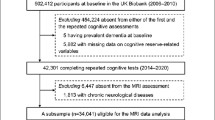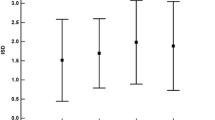Abstract
Baseline cognitive function was established for a study of pre- symptomatic cognitive decline in 1870 men from the general population aged 55–69 years as part of the third examination of the Caerphilly Study. Cognitive assessment included the AH4, a four choice serial reaction time task, a modified CAMCOG, MMSE, NART and various memory tests. Distributions and relationships with age, social class, education and mood at time of testing are presented for a younger population than has previously been available. Multiple linear regression showed cognitive function to be independently associated with all four factors. The age effect was equivalent to one half of a standard deviation (SD) in CRT and AH4 scores. Only the NART score was not associated with age, supporting the use of NART score as an estimate of pre-morbid IQ. The largest age adjusted differences between men with low and normal mood were for the AH4 (3 points, t=5.6, p<0.0001) and the CAMCOG (2 points, t=5.8, p<0.0001). The smallest age adjusted effect of mood was for the CRT (33ms, t=2.14, p=0.32) and the MMSE (0.4 points, t=2.97, p=0.003). Age, mood and education adjusted social class effects were very large ranging between around 0.5 SD for the CRT, and 1.0 SD for the AH4 and NART, respectively. For educational status age, mood and social class adjusted differences were also substantial with tests for trend showing the largest differences for the NART (t=12, p<0.0001) and modified CAMCOG (t=10.6, p<0.0001) with the smallest differences for the CRT (t=2.73, p=0.006).
Similar content being viewed by others
References
Skoog I, Nilsson L, Palmertz B, et al. A population based study of dementia in 85 year olds. N Engl J Med 1993; 328: 153–158.
Ott A, Breteler MMB, van Harskamp F, et al. Prevalence of Alzheimer's disease and vascular dementia: Association with education. The Rotterdam study. Br Med J 1995; 310: 970–973.
Feskens EJM, Havekes LM, Kalmijn S, et al. Apolipoprotein e4 allele and cognitive decline in elderly men. Br Med J 1994; 309: 1202–1206.
MRC CFA Group. Cognitive function and dementia in six areas of England and Wales: The distribution of MMSE and prevalence of GMS organicity case level in the MRC CFA study. Psychol Med 1998; 28: 319–335.
Caerphilly and Speedwell Collaborative group. Caerphilly and Speedwell collaborative heart disease studies. J Epidemiol Community Health 1984; 38: 259–262.
Heim AW. AH4 group test of general intelligence manual. ASE:NFER-Nelson: Windsor, 1976.
Stollery BT. The automated cognitive test (ACT) system. Neurotoxicol Teratol 1996; 18: 493–497.
Roth M, Huppert FA, Tym E, et al. CAMDEX: The Cambridge examination for mental disorders of the elderly. Cambridge: Cambridge University Press, 1988.
Huppert FA, Brayne C, Gill C, et al. CAMCOG — a concise neuropsychological test to assist dementia diagnosis. Socio-demographic determinants in an elderly population. Br J Clin Psychol 1995; 34: 529–541.
Folstein MF, Folstein SE, McHugh PR. Mini-mental state examination. A practical method for grading the cognitive state of patients for the clinician. J Psych Res 1975; 12: 189–198.
Nelson HE. National adult reading test (NART) manual. NFER-Nelson: Windsor, 1982.
Wilson B, Cockburn J, Baddeley A. The Rivermead behavioural memory test manual. Reading: Thames Valley Test Company, 1985.
Chadwick C. On behalf of the MRC multicentre study group of cognitive function and ageing. The MRC multicentre study of cognitive function and ageing: A EURODEM incidence study in progress. Neuroepidemiology 1992; 11(suppl 1): 37–43.
Huppert FA. Cognitive Function. In: Cox BD, Blaxter M, Buckle AJL, Fenner NP, Golding JF, Gore M, Huppert FA, Nickson J, Roth M, Stark J, Wadsworth MEJ, Whichelow M (eds), The health and lifestyle survey: Preliminary report of a national survey of the physical and mental health, attitudes and lifestyle of a random sample of 9003 British adults, Ch 5. London: Health Promotion Research Trust, 1987.
Huppert FA, Whittington JE. Changes in cognitive function in a population sample. In Cox BD, Huppert FA, Whichelow MJ (eds), The health and lifestyle survey: Seven years on. Ch 9, Aldershot: Dartmouth Press, 1993.
Goldberg DP. The detection of psychiatric illness by questionnaire. London: Oxford University Press, 1972.
Rabbitt PMA, Donlan C, Bent N, et al. The University of Manchester Age and Cognitive Performance Research Centre and North East Age Research Longitudinal Programmes, 1982 to 1997. Zeitschrift fur Gerontologie 1993; 26: 176–183.
Fillenbaum GG, George LK, Blazer DG. Scoring nonresponse on the Mini-mental state examination. Psychol Med 1988; 18: 1021–1025.
Rabbitt PMA. Error correction time without external error signals. Nature (London) 1966; 212: 438.
Rabbitt PMA. Errors and error correction in choice response tasks. J Exp Psychol 1966; 71: 264–272.
Brayne C, Gill C, Paykel ES, et al. Cognitive decline in an elderly population — a two wave study of change. Psychol Med 1995; 25: 673–683.
Breteler MMB, Claus JJ, Grobbee DE, et al. Cardiovascular disease and distribution of cognitive function in elderly people: The Rotterdam study. Br Med J 1994; 308: 1604–1608.
White L, Katzman R, Losonczy K, et al. Association of education with incidence of cognitive impairment in three established populations for epidemiological studies of the elderly. J Clin Epidemiol 1994; 47: 363–374.
Rabbitt PMA, Donlan C, Watson P, et al. Unique and interactive effects of depression, age, socioeconomic advantage and gender on cognitive performance in normal healthy older people. Psychol Ageing 1995; 10: 307–313.
Stansfeld SA, Sharp DS, Gallacher JEJ, et al. A population survey of ischaemic heart disease and minor psychiatric disorder in men. Psychol Med 1992; 22: 939–949.
Dufoil C, Fuhrer R, Dartigues J, et al. Longitudinal analysis of the association between depressive symptomatology and cognitive deterioration. Am J Epidemiol 1996; 144: 634–641.
Author information
Authors and Affiliations
Rights and permissions
About this article
Cite this article
Gallacher, J.E., Elwood, P.C., Hopkinson, C. et al. Cognitive function in the Caerphilly study: Associations with age,social class, education and mood. Eur J Epidemiol 15, 161–169 (1999). https://doi.org/10.1023/A:1007576324313
Issue Date:
DOI: https://doi.org/10.1023/A:1007576324313




